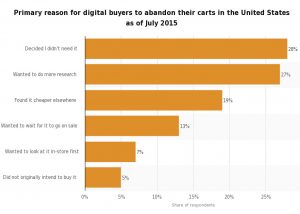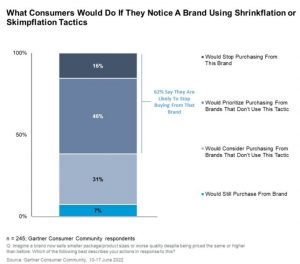We’re only just into 2016 and already talk about ad blocking within the digital marketing industry feels like it’s hit fever pitch. Articles are popping up in the international press about a looming display advertising apocalypse (despite the industry otherwise showing no signs of abatement). Last week, David Chavern, CEO and President of the Newspaper Association of America, wrote a rather doomsday-ish opinion piece on Digiday, saying: “Anything that blocks all types of ads is just blindly punishing journalists, bloggers, publishers and others who rely on ad revenue to survive.”
Ad blocking in the UK has increased
A little dramatic, perhaps, but he has a point. According to Adobe and PageFair, the amount of revenue that publishers are expected to lose to ad blocking worldwide will double by 2017, to $ 41.4 billion. (This does, however, refer to desktop ad-blocking technology; analyst UBS Securities predicted in September last year that, taking into account mobile ad blockers, the effect would be much less with the industry losing around $ 1 billion, or 0.5% of its annual revenue.)
That $ 41.4 billion will be lost on advertising that is stuck in the Mad Men era
The phrase of the year
Not long before Christmas, my colleague David reported on the potential creative opportunities for content from ad blocking software, and this fresh round of industry fretting seems to uphold his analysis.
Personally I don’t see what all the fuss is about. I don’t even look at display ads anymore, much less have the impetus to take five minutes out of my life to block them. And it seems people like me are still in the majority.
Nevertheless, since David’s piece the level of ad blocking in the UK has increased, rising from 15% in June 2015 to 18% in November. In the last year, it rose globally by 41%. By the end of 2015, it was estimated that there were 15 million ad blocker users in the UK and that’s expected to rise to 21 million by the end of this year. It’s something that has held such power of the last year that the Content Marketing Institute declared ‘ad blocking’ its 2015 Phrase of the Year.
The health of digital
So here are a lot of big numbers that suggest that digital display advertising is dying. But this only tells a small part of the story.
Thing is, users on the whole don’t want to block all types of ads. A recent study from the Internet Advertising Bureau UK reports that about three quarters of online users only want to block the ads that interrupt them, with nearly half saying they’d be less inclined to block an ad if it didn’t interfere with their experience.
And when users are told that some websites would have to stop serving free content in order to pay the publisher, 61% say they would prefer to access free content and see ads, while only 4% would willingly pay for content with no ads.
WhatsApp ditches its paywall
Just to add to that, (January 27, 2016), for example, WhatsApp announced that it was ditching its subscription fee imposed after a year of use to allow people all over the world to keep communicating. One concern was that the app, popular in many developing countries, would be rendered inaccessible to people that rely on it yet don’t have a credit card.
The Facebook-owned company wrote on its blog:
“Naturally, people might wonder how we plan to keep WhatsApp running without subscription fees and if today’s announcement means we’re introducing third-party ads. The answer is no. Starting this year, we will test tools that allow you to use WhatsApp to communicate with businesses and organisations that you want to hear from. That could mean communicating with your bank about whether a recent transaction was fraudulent, or with an airline about a delayed flight. We all get these messages elsewhere today – through text messages and phone calls – so we want to test new tools to make this easier to do on WhatsApp, while still giving you an experience without third-party ads and spam.”
Commenting today, Richard Jones, CEO of digital engagement and data acquisition experts EngageSciences, said: “Instead of charging users a fee, the firm will look to charge firms like banks and airlines that want to contact WhatsApp users directly, as a solution to grow capital. The objective being to make ‘communication with businesses’ just as easy for users as it has done with family and friends.”
So while not blocking ads per se, this all goes some way to supporting the notion that users are generally happy with the prospect of content marketing approaches in their app experience, over the implementation of a paywall.
Instead of charging users, the firm will look to charge firms that want to contact WhatsApp users directly
Users don’t mind marketing
What does this all tell you? Well, while the publishers and advertisers might worry about what will be blocked, scant thought seems offered to what won’t. It’s all about user experience; don’t bother them, and they won’t bother you.
Basically the internet doesn’t mind being marketed to. People are fine with digital marketing and advertising as long as it’s relevant to them, offers some real value and primarily doesn’t get in their way and annoy them.
It’s not an ad-pocalypse that’s looming; it’s simply a reflection of the changing needs of today’s consumer. The user doesn’t want to be interrupted, but will happily access marketing content they find relevant and interesting. They fundamentally trust creative content, and fundamentally distrust ads.
It isn’t advertising that’s dying hard at all; only the old habits
Give content a boost
Which goes to further bolster Southerly’s view that content marketers are positioning themselves in the marketing driving seat. That doesn’t mean to the detriment of online advertising, however; the two should be working together. Where advertising requires the skill of content marketing to produce high quality, multimedia adverts that address the needs of the customers they serve without imposition, so too does content marketing have to take a couple of pages out of the paid-for-advertiser’s books to truly maximise the reach of the message. As our Senior Content Strategist Tor pointed out last week, high quality, relevant content that speaks to and addresses the needs of its entire target audience requires a booster. Which you have to pay for.
The simple fact is that it isn’t advertising that’s dying hard at all; only the old habits. Those that continue to operate by pushing obstrusive ads in front of consumers will continue to fall foul of the modern way of marketing. They will lose considerable revenue and unfortunately it is only stubbornness that will prevent them from adapting. That $ 41.4 billion will be lost on advertising that is stuck in the Mad Men era, convinced of its own relevance.
On the other hand, creative content marketing techniques that address the needs of one’s customers and entice new audiences by their very nature bypass the problem. People don’t really want to pay for good content, they just don’t want their experience of it to be hindered. Simply give users the content that they actually want, and they’ll continue to gratefully receive it. More to the point, they’ll choose to receive it.
Digital & Social Articles on Business 2 Community
(14)







